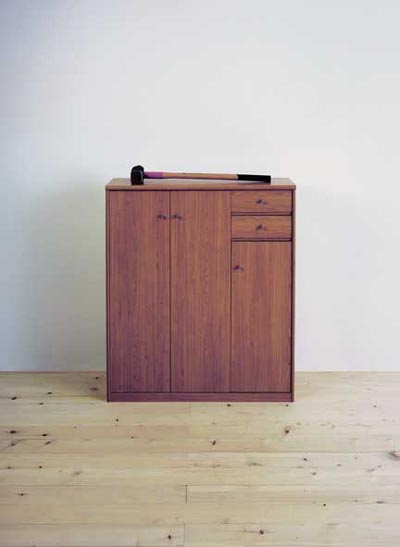 aus der Serie "Art is the better life" (The Revenge), 2003 Ilfochrome hinter Glas gerahmt, 100 x 78 cm Unikat Urs Lüthi The Revenge Click for English text Unter dem Titel "The Revenge" zeigt die Galerie neueste Arbeiten von Urs Lüthi. Dem Künstler wurde durch die Einladung an die Biennale in Venedig (2001) die späte Ehre als "Legende aus den Sechziger- und Siebzigerjahren, aus den süssen und luziden Jahren der Narzisse und Transformer" (Marie-Louise Lienhard) zuteil. Die in unserer Ausstellung gezeigte Video- und Fotoarbeit sowie eine Skulptur greifen insofern das gesamte Oeuvre des Künstlers auf, als dass sie Werkgruppen sind, die als einzelne Teile in einem wechselseitigen Bezug zum Ganzen stehen. Zur sprichwörtlichen Legende wurde Lüthi durch zahlreiche Selbstinszenierungen, die seine eigene Person zum Bildgegenstand erklären. Die Spaltung von Bildobjekt und künstlerischem Subjekt vollzieht sich in dem bereits kanonisch gewordenen Werkzyklus "The Numbergirl" (1973), seinem fotografischen Frühwerk, das bestimmend für das künstlerische Programm geblieben ist. In dieser 20-teiligen Photoserie appelliert Lüthi in exhibitionistischen Posen an den Betrachter, die eigene Identität, das Geschlecht und die Endlichkeit der Existenz zu befragen. Gleichzeitig greift die an Travestie grenzende Zurschaustellung des eigenen Körpers übergeordnete Themen und Motive der klassisch abendländischen Kunst auf – den Halbakt, das Bild im Bild, die Metamorphose. Die fünf Bronzeköpfe aus der Serie "Die Universelle Ordnung" (1989) können als weitere Form der Selbstdarstellung verstanden werden. Allerdings handelt es sich auch bei diesen auf hohen Sockeln inszenierten Skulpturen nicht um das Zeugnis eines unverblümten Narzissmus. Vielmehr vollzieht Lüthi am eigenen Porträt die Typisierung seiner Gesichtszüge und Schädelform, wodurch das Porträt entpersönlicht und zum Spiegel für jedermann wird. Diese Art der Verfremdung bildet auch den inhaltlichen Schwerpunkt von Fotoarbeiten wie "I will be your mirror" (1972) und "Lüthi weint auch für Sie" (1970). Die in den 80er Jahren entstandenen Ornamentbilder treiben die Anonymisierung der Künstlerperson weiter. Der Künstler tritt nicht mehr selbst im Bild auf oder – wie in einer Serie von Schriftbildern aus den 90er Jahren – nur noch als sich selbst vermarktendes Logo, das auf das Foto von einem Bronzeguss zurückgeht. Lüthi bedient sich dabei nicht nur der Präzision technischer Verfahren der Werbeindustrie, sondern auch der Suggestivität der Werbesprache. Die in den Schriftbildern mehrfach übereinandergelagerten Slogans wie "I am beautiful" oder "I am sexy" sind nicht als individuelle Botschaft des Künstlers zu verstehen, sondern als Gemeinplätze, deren Inhaltsleere als Direktive für ein besseres Leben stehen soll. In der in unserer Ausstellung gezeigten 4-teiligen Videoinstallation unternimmt Lüthi einen weiteren Versuch, durch ironische Stilisierung der eigenen Person zum Inbegriff des Allgemeinen zu werden. Der automatisierte Ablauf von Bewegungen, das Zertrümmern einer Kommode mit Inhalt oder das Zerbrechen eines Tellerstapels suggerieren die Vergeblichkeit menschlichen Handelns. Der Versuch des Künstlers, die zahllosen Tellerscherben in mühseliger Kleinarbeit wieder zu einem Ganzen zusammenzusetzen, ist mehr als nur die parodistische Verklärung einer glücksverheissenden Leistungsgesellschaft. Der im Raum plazierte mehrfarbige Abguss des Künstlers greift den Vorgang des Zertrümmerns der Kommode wieder auf. Während im Video der zeitliche Ablauf der Zerstörung festgehalten ist, stellt die Skulptur das Ergebnis dieses "act of revenge" dar. Der Künstler, durch den Kraftakt müde und zufrieden zugleich, schwingt sich jedoch nur scheinbar zum Beherrscher der zerstörten Dinge auf. Vielmehr wirkt sein Tun im Nachhinein sinnentleert und wie der hilflose Versuch, sich über die materielle Begrenztheit alles Wirklichen hinwegzusetzen. Was den Betrachter schliesslich mit Lüthis Rachelust versöhnt, ist seine heiter-frivole Botschaft, dass das Dasein nichts weiter ist als eine grossräumige Bühne, auf der man sich als "Zuschauer seines eigenen Lebens" (Oscar Wilde) ständig neu zu inszenieren hat. (Text: Birgid Uccia) Ausstellungsdauer: 22.3. - 10.5.2003 Öffnungszeiten: Di-Fr 12-18 Uhr, Sa 11-16 Uhr und nach telefonischer Verabredung Galerie Bob van Orsouw Löwenbräum-Areal Limmatstrasse 270 8005 Zürich Telefon: 01 273 11 00 Fax: 01 273 11 02 E-Mail: mail@bobvanorsouw.ch  from the series "Art is the better life"(The Revenge), 2003 Sculpture, lifesize, mixed media Urs Lüthi The Revenge We are pleased to announce "The Revenge", an exhibition of Urs Lüthi's most recent works. In 2001, Lüthi's invitation to participate in the Venice Biennale belatedly honoured him as a "legend from the 1960s and 70s, from that sweet, lucid time of narcissists and transformers" (Marie-Louise Lienhard). On show will be a sculptural piece and an installation combining video and photography, which in themselves embrace the artist's work as a whole in that both of these ensembles relate individually to his output. Lüthi became a legend in his own time for numerous works in which he featured his own person as the pictorial object. This dichotomy between pictorial object and artistic subject is seen as early as 1973 in his, by now canonic, "Numbergirl" (1973), an early photographic piece that has coloured his artistic programme ever since. In this 20-part photo-series Lüthi – in exhibitionist poses – exhorts viewers to question their own identity, their sexuality and the finitude of human existence. At the same time, this exposure of his own body – bordering on travesty – picks up on bigger themes and motifs in classical Western art – semi-nudes, the picture within a picture, metamorphosis. The five bronze heads from the series "Die Universelle Ordnung" (1989) can be read as another form of self-exposure – although these sculptures on high plinths are not simply the products of unashamed narcissism. Rather Lüthi extracts typical traits from his own features and skull-shape thus de-personalising his portrait and turning it into a mirror for Everyman. This form of alienation is also at the heart of photographic works like "I will be your mirror" (1972) and "Lüthi weint auch für Sie" (1970). Lüthi's ornamental compositions from the 1980s take the anonymity of his artistic persona a stage further. The artist no longer appears in person in the image, or at most – as in a series of text-based images made in the 1990s – only as a self-promoting logo that goes back to a photograph of a bronze cast. Lüthi not only exploits the precision of the technical processes used in advertising, but also adopts the suggestive language of commercial copy-writers. The multiple images of slogans like "I am beautiful" or "I am sexy" are not to be read as a personal statement by the artist but as empty platitudes that are supposed to help us to lead more fulfilled lives. In the 4-part video installation on show in our exhibition, Lüthi seeks again – through the ironic stylisation of his own person – to embody the epitome of human existence in its widest sense. Automated sequences of movements, demolishing a chest of drawers with its contents or smashing a stack of plates all suggest the futility of human actions. The artist's attempt to painstakingly put the crockery smithereens back together again is more than just a parody of the promise of happiness held out by a society obsessed with achievement. The multi-coloured cast of the artist, sharing the same space, takes up the notion of demolishing a chest of drawers. While the video captures the temporal sequence of the action, the sculpture depicts the result of this act of revenge. The artist, tired but satisfied by his exertions, is only superficially the master of what he has destroyed. For now, in retrospect, his actions seems devoid of meaning and no more than a helpless attempt to overcome the material limitations of the reality around us. Ultimately, however, Lüthi's thirst for revenge is mitigated for the viewer by the work's other more light-hearted, even frivolous message that human existence is nothing more than an expansive stage where the individual, as the "observer of his own life" (Oscar Wilde) is forever casting him or herself in new roles. (Text by Birgid Uccia) |